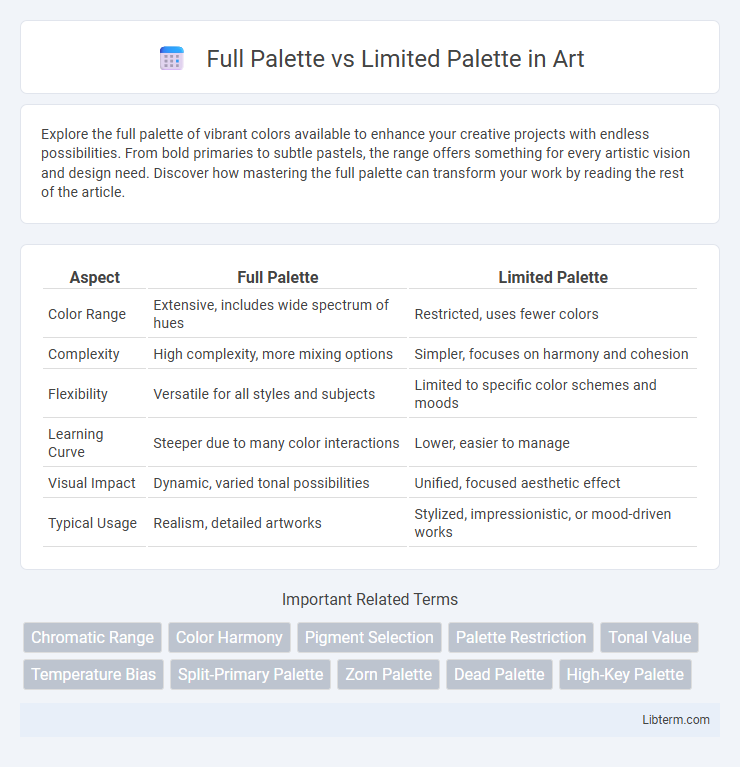Explore the full palette of vibrant colors available to enhance your creative projects with endless possibilities. From bold primaries to subtle pastels, the range offers something for every artistic vision and design need. Discover how mastering the full palette can transform your work by reading the rest of the article.
Table of Comparison
| Aspect | Full Palette | Limited Palette |
|---|---|---|
| Color Range | Extensive, includes wide spectrum of hues | Restricted, uses fewer colors |
| Complexity | High complexity, more mixing options | Simpler, focuses on harmony and cohesion |
| Flexibility | Versatile for all styles and subjects | Limited to specific color schemes and moods |
| Learning Curve | Steeper due to many color interactions | Lower, easier to manage |
| Visual Impact | Dynamic, varied tonal possibilities | Unified, focused aesthetic effect |
| Typical Usage | Realism, detailed artworks | Stylized, impressionistic, or mood-driven works |
Introduction to Color Palettes in Art
A full palette in art provides a wide range of colors, allowing for greater versatility and complexity in mixing hues to achieve nuanced tones and shades. Limited palettes use fewer colors, often focusing on complementary or analogous hues, fostering harmony and simplicity in the artwork while challenging the artist's creativity with color mixing. Understanding the distinctions between full and limited palettes is essential for mastering color theory and developing a unique artistic style.
What is a Full Palette?
A full palette in art consists of a wide range of colors, typically including primary, secondary, tertiary hues, and multiple shades, tints, and tones, offering extensive color mixing possibilities. Artists utilize a full palette to achieve precise color variation, depth, and richness in their work, making it ideal for complex and detailed paintings. This approach contrasts with a limited palette, which uses fewer colors to create harmony and simplicity but limits color variety.
Understanding the Limited Palette
A limited palette consists of a small selection of colors, typically three to six, chosen to create harmony and cohesion in artwork. Understanding the limited palette helps artists control color relationships, simplify mixing, and achieve a consistent mood or style throughout a piece. This approach reduces the risk of color clashes and challenges the artist to explore the depth and variety achievable from fewer pigments.
Historical Perspectives on Palette Choices
Historical perspectives on palette choices reveal that artists have oscillated between full palettes and limited palettes based on cultural and technological contexts. Renaissance painters favored full palettes to achieve realism through extensive pigment variety, while modernists often embraced limited palettes to emphasize form and emotional expression. Scientific advancements in pigment creation and trade routes significantly influenced the availability and preference for broader or more restricted color ranges throughout art history.
Advantages of a Full Palette
A full palette offers artists access to an extensive range of colors, enabling precise color mixing and greater creative flexibility. It enhances the ability to achieve subtle gradients, complex tones, and accurate color representation in artwork. This comprehensive color selection supports diverse styles and subjects, making it ideal for professional and detailed painting projects.
Benefits of Using a Limited Palette
Using a limited palette enhances color harmony by restricting the color selection, ensuring cohesive and balanced visuals. It simplifies decision-making during the creative process, allowing artists to focus on composition and texture rather than selecting from an overwhelming range of colors. Limited palettes also encourage experimentation with value, saturation, and blending techniques, fostering unique and unified artwork.
Challenges of Full vs Limited Palettes
Full palettes offer a vast range of colors, which can lead to challenges in color management, increased complexity in design decisions, and potential inconsistencies in brand identity. Limited palettes simplify choices, reducing decision fatigue and ensuring more cohesive visual communication but can restrict creativity and detail precision. Balancing the richness of full palettes with the constraint-based clarity of limited palettes remains a primary challenge in effective color strategy.
Color Harmony and Palette Selection
Full palettes offer a wide range of hues, enabling complex color harmony through complementary, analogous, and triadic schemes, ideal for versatile design needs. Limited palettes restrict the color selection, emphasizing cohesion and simplicity while enhancing visual impact by focusing on a few harmonious tones. Effective palette selection depends on project goals, balancing versatility and clarity to optimize aesthetic appeal and communication.
Choosing the Right Palette for Your Style
Selecting the right palette depends on your personal style and project goals, with a full palette offering extensive color variety for vibrant, complex designs, while a limited palette emphasizes harmony and cohesion through fewer, carefully chosen shades. A full palette suits artists and designers seeking versatility and dynamic expression, whereas a limited palette appeals to minimalist aesthetics or those aiming for a unified, elegant look. Understanding the emotional impact of color combinations and the context of your work ensures an effective palette choice that enhances visual storytelling.
Tips for Experimenting with Palettes
When experimenting with palettes, start by defining the mood and purpose of your design to guide your color choices within a full or limited palette. Use color theory principles such as complementary, analogous, or triadic schemes to create harmony and contrast. Test your palette across different mediums and lighting conditions to ensure versatility and visual consistency.
Full Palette Infographic

 libterm.com
libterm.com